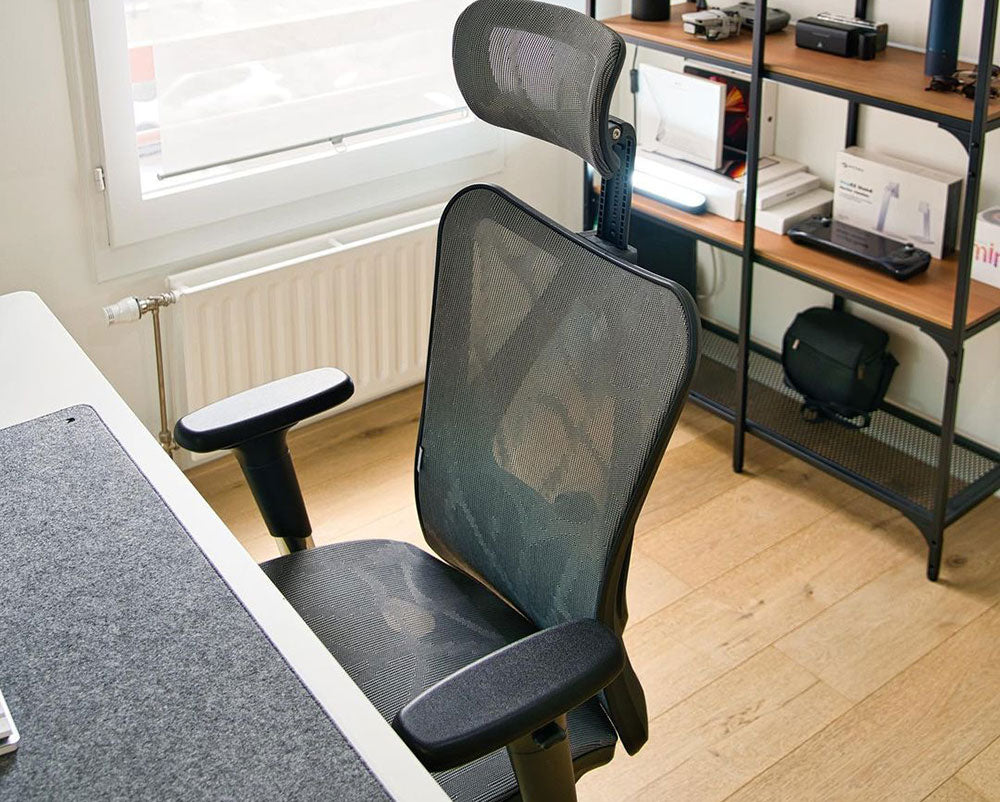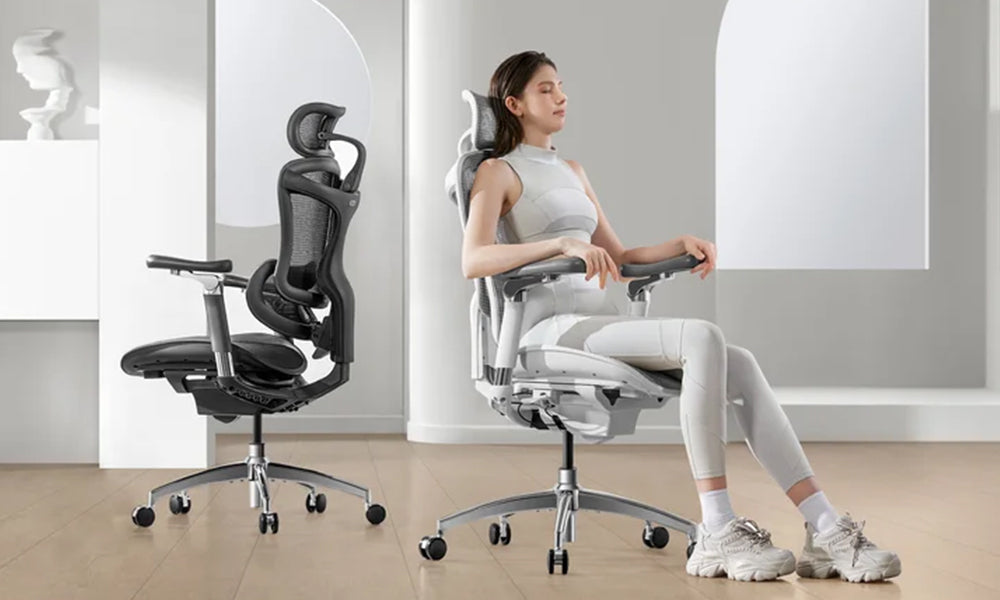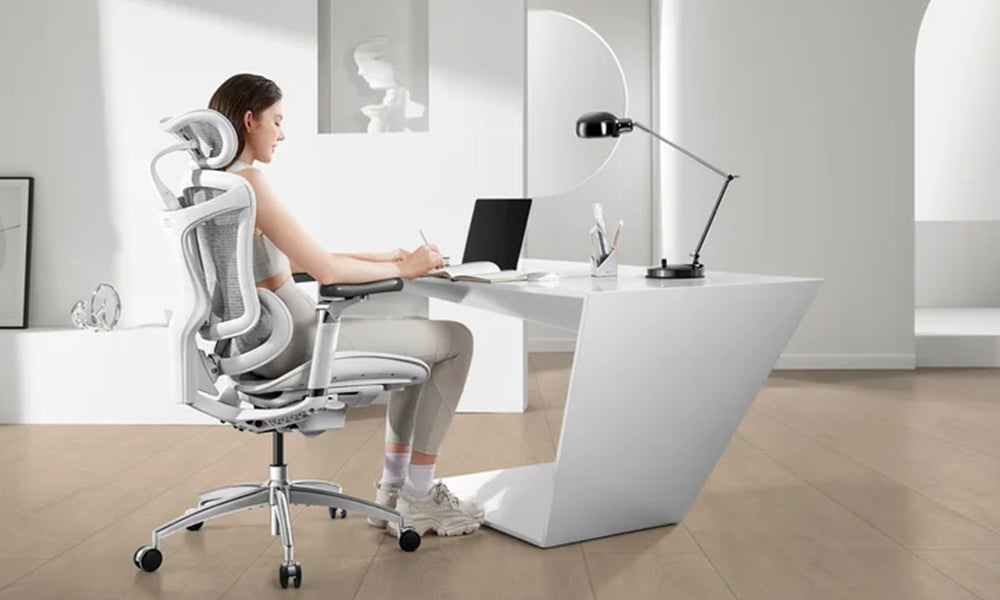In today's sedentary lifestyle, we spend a lot of time sitting, be it in the office, at home or on the go. Unfortunately, this habit can lead to back problems that can interfere with our day-to-day lives. An important step in preventing back problems is choosing an ergonomic office chair that provides optimal back support. In this article, we take a look at different types of ergonomic chairs, their benefits, and how they can reduce back pain.
Why is choosing the right chair important?
An inadequate chair can lead to poor posture, which in turn puts strain on your back and can lead to pain and tension. An ergonomic chair, on the other hand, promotes a better sitting position and relieves strain on the back by supporting the natural curvature of the spine. The right choice of chair can thus prevent back problems in the long term.
Characteristics of a good ergonomic office chair
2.1. Adjustable seat height and seat depth
A quality ergonomic chair allows the user to adjust the seat height and depth to suit their individual needs. A correct seat height ensures that your feet are flat on the floor and your knees are bent at right angles. Proper seat depth allows the user to lean their back against the backrest without the chair being too deep or too flat.
2.2. lumbar support
An adjustable lumbar support is a crucial feature of an ergonomic office chair. This support conforms to the natural curve of the lower back and relieves pressure on the lumbar spine, reducing stress and promoting upright posture.
2.3. backrest
The backrest should be adjustable to support the individual shape of the back. A reclined backrest promotes dynamic sitting that keeps the back moving and reduces the strain that can result from prolonged, rigid sitting.
2.4. armrests
Height-adjustable armrests allow the user to keep their arms in a comfortable position and eliminate tension in the shoulders and neck. Ideally, the armrests should be positioned close to the body to ensure a relaxed arm position.
2.5. Breathable padding
Breathable padding is important to minimize sweating and discomfort while sitting. High-quality chairs are often equipped with fabrics that absorb moisture and allow good air circulation.
Different types of ergonomic chairs
3.1. Ergonomic office chair
Office workers typically spend many hours a day at their desks. An ergonomic office chair is therefore crucial to avoid back problems. These chairs offer all of the above features and support a healthy sitting posture during long working hours.
3.2. Ergonomic kneeling chair
An ergonomic kneeling chair promotes an upright sitting position that shifts the weight to the knees and shins. This can reduce the pressure on the lumbar spine and strengthen the back muscles. However, people with knee or ankle problems should exercise caution as this type of chair can put extra pressure on the knee joints.
3.3. ball chair
A ball chair is an interesting alternative to conventional office chairs. It consists of a large exercise ball positioned in a frame. Sitting in a ball chair requires constant adjustment to maintain balance, which strengthens core muscles and encourages movement. However, ball chairs may not provide enough back support for long-term periods of sitting.
3.4. executive chair
Executive chairs are usually luxuriously upholstered and equipped with many adjustment options. Although some models have good ergonomic properties, not all executive chairs are suitable for back health. Before buying, you should therefore make sure that the chair has the necessary ergonomic features.

How can an ergonomic chair relieve back pain?
4.1. spine support
An ergonomic chair with adjustable lumbar support encourages the natural curvature of the spine and relieves pressure on the intervertebral discs, which can lead to a reduction in back pain.
4.2. Improved blood circulation
An optimal sitting position improves blood flow, as there are no constricting pressure points. Better circulation promotes the supply of nutrients and oxygen to the muscles, which reduces tension and muscle fatigue.
4.3. Relief of the neck and shoulder muscles
Height-adjustable armrests support a relaxed arm position, which reduces strain on the neck and shoulder muscles and prevents tension.
4.4. promoting movement
An ergonomic chair with a reclined backrest promotes dynamic sitting. This encourages the user to engage back muscles and stretch regularly, reducing stiffness and relieving stress on the back. By actively sitting on such a chair, the muscles remain in motion and are not strained by long, rigid sitting.
4.5. Reduction of pressure points
An ergonomic chair with a well-padded seat and breathable materials will ensure there are no uncomfortable pressure points that can cause pain and discomfort. The right padding distributes the body weight evenly and thus ensures a more comfortable sitting position.
Ergonomic chairs for specific back problems
5.1. lumbar support
People who suffer from low back problems should look for a chair with an adjustable lumbar support. This function makes it possible to adapt the chair to the individual curvature of the lower back and thus specifically relieve the lumbar spine.
5.2. disc prolapse
It is important for people with a herniated disc to choose a chair that offers even pressure distribution and does not put additional strain on the spine. A chair with good padding and an adjustable backrest can reduce pressure on the affected area and aid in the healing process.
5.3. scoliosis
People with scoliosis should look for an ergonomic chair that allows for customization to accommodate the curvature of their spine. An adjustable backrest and lumbar support can help keep the spine in as neutral a position as possible and reduce discomfort.
Tips for choosing the best chair
6.1. test seat
Before you buy an ergonomic chair, it's important to try it on and make sure it fits your height and shape. Try on different models to find the best chair for your needs.
6.2. consider budget
Ergonomic chairs can come in different price ranges. However, it is wise to invest in a quality chair that will support your back health. Remember that investing in your health and avoiding expensive treatments for back problems can be cheaper in the long run.
6.3. read reviews
Read customer reviews and testimonials to gain insight into the quality and effectiveness of a specific ergonomic office chair. The opinions of other users can help you make a decision.
6.4. Develop ergonomic habits
An ergonomic chair alone cannot completely eliminate your back problems. It's also important to develop other ergonomic habits, like taking regular breaks to stand up and stretch, setting the screen at the right height, and maintaining a good sitting position.
Conclusion
An ergonomic chair is an essential aid in preventing back problems and promoting a healthy sitting posture. By supporting the spine, improving circulation and reducing pressure points, a good ergonomic chair can lead to improved back health in the long term.
When choosing an ergonomic office chair, it is important to consider individual needs and possible back problems. Try out different models and choose a chair that offers the best features for your back health.
Invest in your back health and develop ergonomic habits to benefit from an ergonomic chair in the long term. With the right support and posture, you can reduce back pain and improve your productivity and quality of life. Choose your ergonomic chair wisely and support your spine in every situation.



